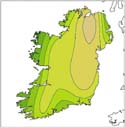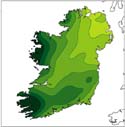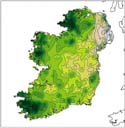| 2004 |

|
YEAR BOOK |
Met �ireann
|
The C4I Project
|

Climate Modelling
The scientific evidence is growing that man-made greenhouse gas emissions are having a significant effect on the earth's climate. Convincing evidence is provided by sophisticated computer models that simulate the multitude of processes and feedback systems controlling the climate. By running the models for past periods, the sensitivity of the climate to greenhouse gases can be estimated and the accuracy of the models assessed by comparing the output to observations. Equally, the models can be run forward into the future and the response of the climate system to predicted greenhouse gas concentrations evaluated.
However, even with powerful supercomputers, climate simulations using coupled atmosphere-ocean general circulation models are feasible only with horizontal resolutions of around 300km. Considering the size of Ireland, the information provided by such global models is rather coarse in scale.
More detailed information can be obtained by using a Regional Climate Model (RCM), which focuses on a limited area of the globe. Its role is to dynamically downscale the relatively coarse-grained information provided by the global models. In its simplest form, the RCM can focus solely on the atmosphere, while relying on the global model to update changes in sea surface temperatures etc. This allows a more refined computational grid to be used � typically, RCM simulations run at horizontal resolutions in the range 10-20km.
The impact of the increased RCM resolution on forecast precipitation can be seen in the diagrams, which show a climate simulation of precipitation for January 1991 using both Global and Regional Climate Models. Clearly, the increased resolution of the RCM gives a much more realistic estimate of precipitation over Ireland.
| Global Model Precipitation Jan. 1991 | RCM Precipitation Jan. 1991 | Observed Precipitation Jan. 1991 |

|

|

|

C4I's Regional Climate Model
C4I makes use of a Regional Climate Model developed at the Rossby Centre in Sweden. Model research and simulation work are carried out in the Regional Climate Analysis and Prediction Centre in Met �ireann, while system analysis and code development activities are centred at University College, Dublin.
Currently the supercomputer facilities at the European Centre for Medium-Range Weather Forecasts in Reading, England, are used for climate simulations. Later it is planned to run the model on a Grid computer system (CosmoGrid) funded under the Programme for Research in Third Level Institutions (PRTLI). Work on the development of a Grid-capable version of the RCM is well advanced and the model has been tested on Grid prototypes.
C4I's principal goal is to build a capability for addressing climate change issues specific to national needs, and to provide a support framework for wider climate-related research activities in Ireland. Such research is essential for gaining a better understanding of the potential impacts of climate change and the adaptation strategies which may be needed to cope with them.
Funding for the C4I Project is provided by the Environmental Protection Agency, Sustainable Energy Ireland, the Higher Education Authority, and Met �ireann.
Contact: Ray McGrath, Research and Applications Division, Met �ireann, Glasnevin Hill, Dublin 9;
E-mail: [email protected]